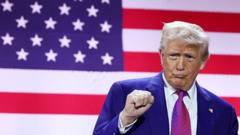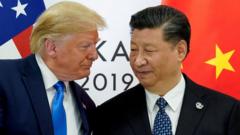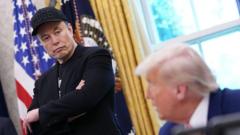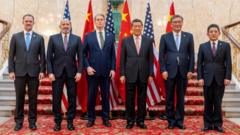President Trump's new tariffs are facing legal opposition, yet historical context and early economic responses hint at a revival of American manufacturing, showcasing the complexities of trade policy in the current political landscape.
Legal Battles Erupt Over President Trump's New Tariff Strategy

Legal Battles Erupt Over President Trump's New Tariff Strategy
A coalition of Democratic state attorneys general challenges Trump's recent tariff policy, while economic indicators suggest potential benefits for U.S. industries.
Article Text:
President Donald Trump’s new tariff initiative, designed to address long-standing trade disparities, is encountering significant legal hurdles from a group of Democratic state attorneys general. The coalition is arguing that the implementation of such tariffs exceeds the boundaries of executive authority, claiming that the president has imposed broad import duties without the necessary congressional endorsement.
In defense, Trump’s legal team cites the legitimacy of his actions under previous legislative frameworks, notably the Trade Expansion Act of 1962 and the International Emergency Economic Powers Act, both of which afford the executive branch considerable latitude when confronting threats to national security or economic integrity.
Historical precedents indicate that tariffs can be an effective economic strategy. In the 19th century, the United States relied heavily on tariffs to finance government operations and bolster nascent American industries. Prominent figures such as Abraham Lincoln and Theodore Roosevelt championed tariffs to safeguard domestic manufacturing and protect American labor from competitive practices of foreign nations.
Modern examples further demonstrate the effectiveness of targeted tariffs. During Trump’s earlier tenure, tariffs imposed on steel and aluminum revitalized pivotal sectors of the economy, resulting in job creation and bolstering supply chain autonomy. The initial impacts of Trump’s new tariff policy, dubbed the “Liberation Day Tariffs,” are already observable, with several companies planning to relocate manufacturing operations back to the U.S. in response to increased import costs.
The Trump administration's rationale underscores that true free trade requires equity. For years, nations including China and Vietnam have engaged in trade manipulation, providing subsidies to their own industries and flooding the U.S. market with underpriced imports. By implementing tariffs, Trump aims to renegotiate the international trade framework, compelling global partners to reduce their barriers or confront repercussions.
In a clear response to these policy changes, over 130 countries have initiated discussions with U.S. trade representatives to negotiate lower tariffs, indicating that strong negotiation can yield quicker results than prolonged bureaucratic procedures.
As legal challenges from Democratic states wend their way through the judicial system, it’s evident that President Trump’s tariff policies are grounded in historical and economic rationale. Far from a reckless decision, this “reciprocal tariff” approach aligns with established practices that once positioned America as a leader in manufacturing.
With American factories beginning to reopen and international stakeholders showing readiness to renegotiate outdated agreements, the preliminary assessment is promising: Trump's tariffs are already producing tangible results.
President Donald Trump’s new tariff initiative, designed to address long-standing trade disparities, is encountering significant legal hurdles from a group of Democratic state attorneys general. The coalition is arguing that the implementation of such tariffs exceeds the boundaries of executive authority, claiming that the president has imposed broad import duties without the necessary congressional endorsement.
In defense, Trump’s legal team cites the legitimacy of his actions under previous legislative frameworks, notably the Trade Expansion Act of 1962 and the International Emergency Economic Powers Act, both of which afford the executive branch considerable latitude when confronting threats to national security or economic integrity.
Historical precedents indicate that tariffs can be an effective economic strategy. In the 19th century, the United States relied heavily on tariffs to finance government operations and bolster nascent American industries. Prominent figures such as Abraham Lincoln and Theodore Roosevelt championed tariffs to safeguard domestic manufacturing and protect American labor from competitive practices of foreign nations.
Modern examples further demonstrate the effectiveness of targeted tariffs. During Trump’s earlier tenure, tariffs imposed on steel and aluminum revitalized pivotal sectors of the economy, resulting in job creation and bolstering supply chain autonomy. The initial impacts of Trump’s new tariff policy, dubbed the “Liberation Day Tariffs,” are already observable, with several companies planning to relocate manufacturing operations back to the U.S. in response to increased import costs.
The Trump administration's rationale underscores that true free trade requires equity. For years, nations including China and Vietnam have engaged in trade manipulation, providing subsidies to their own industries and flooding the U.S. market with underpriced imports. By implementing tariffs, Trump aims to renegotiate the international trade framework, compelling global partners to reduce their barriers or confront repercussions.
In a clear response to these policy changes, over 130 countries have initiated discussions with U.S. trade representatives to negotiate lower tariffs, indicating that strong negotiation can yield quicker results than prolonged bureaucratic procedures.
As legal challenges from Democratic states wend their way through the judicial system, it’s evident that President Trump’s tariff policies are grounded in historical and economic rationale. Far from a reckless decision, this “reciprocal tariff” approach aligns with established practices that once positioned America as a leader in manufacturing.
With American factories beginning to reopen and international stakeholders showing readiness to renegotiate outdated agreements, the preliminary assessment is promising: Trump's tariffs are already producing tangible results.





















